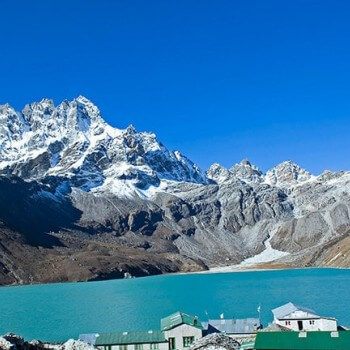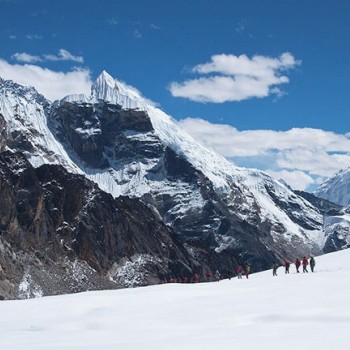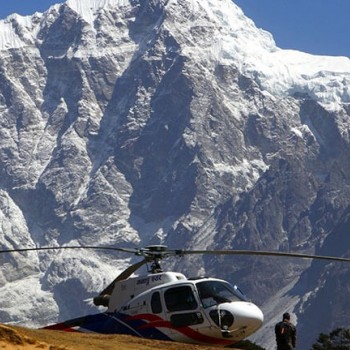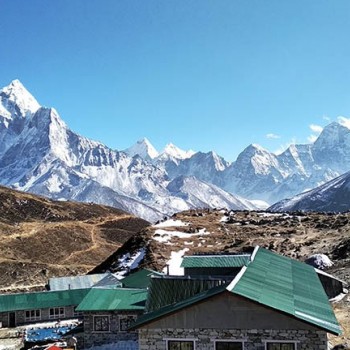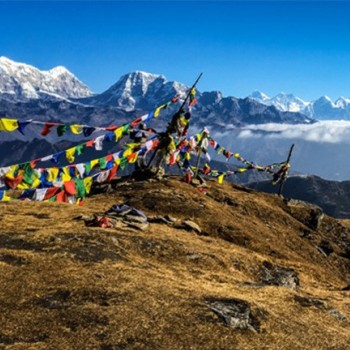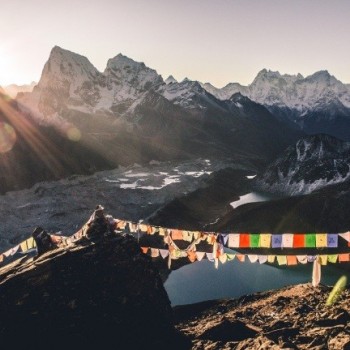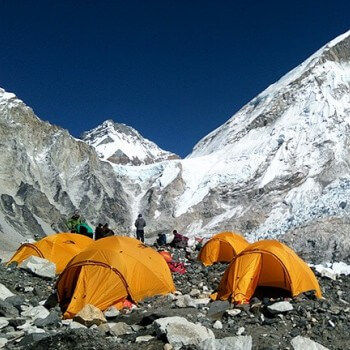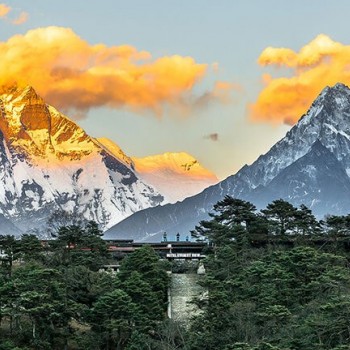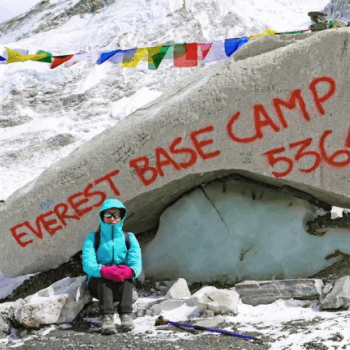Trip Details
Destination: Nepal
Trip Difficulty: Easy
Trip Style: Trekking
Transport: Public Vehicle
Food: Breakfast, Lunch & Dinner
Accommodation: Teahouse or Lodge
Group Size: 1-16
Max Elevation: 4065m
Highlights
- Panoramic Views: Pikey Peak is renowned for its panoramic views of the Himalayas, including Mount Everest, Mount Kanchenjunga, Makalu, and other peaks.
- Sunrise and Sunset: The sunrise and sunset views from Pikey Peak are spectacular, with the sun casting a golden glow on the snow-capped peaks.
- Cultural Experience: The trek to Pikey Peak offers a rich cultural experience as it passes through traditional Sherpa and Tamang villages. You can explore local monasteries and interact with the friendly locals.
- Diverse Landscapes: The trail features diverse landscapes, from lush green forests and rhododendron groves to alpine meadows and rugged mountain terrain.
- Less Crowded: Compared to other popular trekking routes in Nepal, Pikey Peak is less crowded, providing a more serene and peaceful trekking experience.
- Accessibility: The trek to Pikey Peak is relatively accessible and can be completed in a shorter duration, making it suitable for trekkers with limited time.
- Buddhist Monasteries: Along the trek, you'll encounter several ancient Buddhist monasteries, offering insight into the local spiritual practices and heritage.
- Local Cuisine: The teahouses and lodges along the route serve delicious local cuisine, providing an opportunity to enjoy traditional Nepali and Sherpa dishes.
Description
The Pikey Peak Trek, located in the Solu-Khumbu region of Nepal, offers trekkers a unique blend of natural beauty, cultural richness, and panoramic mountain views. This trek is named after the sacred Pikey Peak (4,065 meters), which holds significant cultural and spiritual importance for the local Sherpa community. The Pikey Peak Trek provides an alternative to the more crowded Everest Base Camp route, promising serenity and unspoiled landscapes.
The Pikey Peak Trek typically spans 5-7 days, depending on the chosen itinerary and starting point. A common route begins at Phaplu, passing through villages like Chyangba, Jhapre, and Junbesi before reaching Pikey Peak. Each day's trek offers diverse landscapes, from terraced fields to alpine forests, culminating in the majestic views from the peak.
The region is rich in biodiversity, with opportunities to spot various species of birds, including the vibrant Danphe (Himalayan Monal), Nepal's national bird. The forests are home to Himalayan flora such as rhododendrons, magnolias, and pine trees. Nature enthusiasts can explore these diverse ecosystems and enjoy the tranquility of the natural surroundings.
Why Choose Pikey Peak Trek?
The Solu-Khumbu region, home to the legendary Sherpas, has a rich history intertwined with mountaineering and Buddhism. The area became globally known after Sir Edmund Hillary and Tenzing Norgay's successful ascent of Mount Everest in 1953. The Pikey Peak region, in particular, has been a spiritual site for the Sherpas, with its name derived from the local deity, Pikey, representing the sky and the weather.
Embark on the journey of a lifetime to Pikey Peak, where nature's grandeur meets cultural richness. Whether you seek adventure, spiritual enlightenment, or simply a rejuvenating escape, the Pikey Peak Trek promises an unforgettable experience amidst the towering Himalayas.
The Pikey Peak Trek is an excellent adventure for beginners, offering a perfect blend of natural beauty, cultural richness, and manageable challenges. The panoramic views, serene trails, and warm hospitality of the local people make this trek a memorable experience. Embark on this journey, and you'll return with a deeper appreciation for the Himalayas and the vibrant cultures of Nepal.
Useful Information
Must-Visit Attractions
Pikey Peak Summit
The highlight of the trek is reaching the summit of Pikey Peak, standing at an altitude of 4,065 meters. The panoramic views from the top are truly awe-inspiring, offering a glimpse of some of the world's highest mountains.
Monasteries
Along the trekking route, trekkers will encounter several Buddhist monasteries and stupas, adding a spiritual dimension to the journey. These ancient monastic sites provide insights into the religious and cultural heritage of the region.
Sunrise and Sunset Views
Witnessing the sunrise and sunset from Pikey Peak is a mesmerizing experience. The changing colors of the sky and the panoramic mountain vistas create unforgettable memories.
Best Time to Trek Pikey Peak
The best times to start the Pikey Peak Trek are during the spring (March to May) and autumn (September to November) seasons. During these periods, the weather is stable, and the skies are generally clear, providing the best conditions for trekking and panoramic views.
Spring (March to May)
In spring, the hills are adorned with blooming rhododendrons and other wildflowers, making the landscapes exceptionally vibrant. The temperatures are moderate, and the weather is mostly clear, making it an ideal time for trekking.
Autumn (September to November)
Autumn is characterized by clear skies and stable weather, offering spectacular views of the Himalayan range. The post-monsoon freshness adds to the scenic beauty, and the trails are in excellent condition.
Trek Difficulty
The Pikey Peak Trek is considered a moderate trek. It is suitable for both novice trekkers and experienced hikers. While the trails are less challenging than those in higher-altitude regions, trekkers should be prepared for significant daily altitude gains and losses and be in good physical condition.
Key Factors Affecting Trek Difficulty
- Altitude: The highest point on this trek is Pikey Peak at 4,065 meters. Proper acclimatization is essential to avoid altitude sickness.
- Terrain: The trek involves various terrains, including rocky paths, forest trails, and steep ascents and descents.
- Daily Walking Hours: Trekkers can expect to walk for 5-7 hours each day, depending on the pace and specific itinerary.
Essential Gear and Equipment
To ensure a safe and comfortable trekking experience, it is crucial to pack appropriately. Here is a list of essential gear and equipment:
- Clothing: Layered clothing suitable for varying temperatures, including thermal wear, fleece jackets, waterproof jackets, and trekking pants.
- Footwear: Sturdy trekking boots, comfortable hiking socks, and gaiters.
- Accessories: Sunglasses, a hat, gloves, and a headlamp with extra batteries.
- Backpack: A durable backpack with a rain cover.
- Sleeping Gear: A warm sleeping bag suitable for cold weather.
- Miscellaneous: Trekking poles, water purification tablets, first aid kit, and personal toiletries.
Accommodation and Meals
During the Pikey Peak Trek, accommodation is typically in teahouses** and odges. These provide basic amenities such as a bed, blanket, and shared bathrooms. Meals are generally a mix of traditional Nepali dishes like dal bhat (lentil soup with rice), as well as international cuisine options.
Teahouses
Teahouses are the primary form of accommodation along the trekking route. They are run by local families, offering a glimpse into the daily lives and culture of the Sherpa community.
Meals
Expect hearty and nutritious meals designed to keep your energy levels high. Sherpa cuisine offers a delightful array of dishes, including dal bhat (rice and lentils), momos (dumplings), thukpa (noodle soup), and chang (local alcoholic beverage). Exploring the local cuisine is an integral part of the trekking experience. Indulge in the delicious flavors of Sherpa cuisine, including yak meat dishes, Sherpa stew, Tibetan bread, and locally brewed chang. Exploring the local culinary delights adds a delightful dimension to the trekking experience.
Permits and Regulations
To trek in the Pikey Peak region, you will need the following permits:
- TIMS (Trekkers' Information Management System) Card
- Gaurishankar Conservation Area Permit (GCAP)
These permits can be obtained in Kathmandu through authorized trekking agencies or from the Nepal Tourism Board.
Health and Safety Tips
- Altitude Sickness: Be aware of the symptoms of altitude sickness and acclimatize properly. Stay hydrated and take it slow.
- Travel Insurance: Ensure you have comprehensive travel insurance that covers high-altitude trekking and emergency evacuation.
- Local Guides: Hiring a local guide can enhance your trekking experience and provide valuable insights into the region's culture and natural beauty.
The Pikey Peak Trek is a hidden gem in the Everest region, offering a perfect blend of natural beauty, cultural richness, and adventure. Whether you are a seasoned trekker or a novice looking for an unforgettable experience, this trek has something to offer everyone. The serenity of the trails, combined with the awe-inspiring views of the Himalayas, makes Pikey Peak a must-visit destination for trekking enthusiasts.
FAQs
How long is the Pikey Peak Trek?
The Pikey Peak Trek typically takes about 5 days, including travel to and from Kathmandu.
Do I need prior trekking experience for the Pikey Peak Trek?
No prior trekking experience is necessary, but being in good physical condition and having some level of fitness will make the trek more enjoyable.
What is the highest point of the Pikey Peak Trek?
The highest point is Pikey Peak itself, which stands at 4,065 meters (13,333 feet).
Is altitude sickness a concern on this trek?
Altitude sickness can be a concern. It is essential to acclimatize properly, stay hydrated, and be aware of the symptoms of altitude sickness.
What kind of food can I expect on the trek?
You can expect a variety of meals including traditional Nepali dishes like dal bhat, as well as international options such as pasta, noodles, and soups.
Are there any cultural highlights on this trek?
Yes, the trek offers several cultural highlights including visits to Sherpa villages, ancient monasteries, and the opportunity to experience the local way of life.
Do I need a guide for the Pikey Peak Trek?
While it is possible to trek independently, hiring a local guide is highly recommended for navigation, cultural insights, and safety.

.jpeg)

